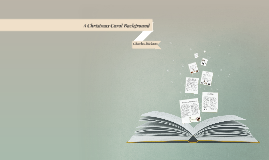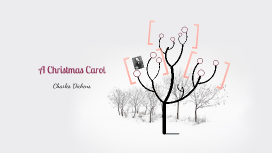A Christmas Carol Background
Transcript: Conventions and Techniques -emphasis on imagery -"detailed attention to and elaboration of surfaces" (Jaffe254) "Oh! But he was a tightfisted hand at the grindstone, Scrooge! a squeezing, wrenching, grasping, scraping, clutching, covetous, old sinner! Hard and sharp as flint, from which no steel had ever struck out generous fire; secret, and selfcontained, and solitary as an oyster." (Dickens 1) -use of leitmotif Scrooge: "The cold within him froze his old features...He carried his own low temperature always about with him" (Dickens 1) Scrooge's Nephew: "He had so heated himself with rapid walking in the fog and frost, this nephew of Scrooge's, that he was all in a glow his face was ruddy and handsome his eyes sparkled, and his breath smoked again." (Dickens 2) -moral intentions A Christmas Carol "makes a vigorous plea for Christian charity." (Harrison 263) -focuses on the central moral idea of imagination -empathy/sympathy Sympathy was a term that was frequently mentioned in Victorian literature. (Harrison) My own connections to this timeless tale... Works Cited Harrison, Mary Catherine. "The Paradox of Fiction and the Ethics of Empathy: Reconceiving Dickens's Realism." Narrative. Vol. 16. No. 3. (2008) pp256-278. Jaffe, Audrey. "Spectacular Sympathy: Visuality & Ideology in Dickens's A Christmas Carol" PMLA. Vol. 109. No. 2. (1994) pp254-265. Anderson, Doug D. "Appendix D: English Society in the 1840s." Appendix D: English Society in the 1840s. N.p., n.d. Web. 21 Oct. 2012. <http://www.hymnsandcarolsofchristmas.com/History/English_Society_in_the_1840s.htm>. "Charles Dickens(1812-1870)." Charles Dickens. N.p., n.d. Web. 22 Oct. 2012. <http://orwell.ru/people/dickens/>. "A Christmas Carol." Enotes.com. Gale Cengage, 2002. Web. 23 Oct. 2012. <http://www.enotes.com/christmas-carol-criticism/christmas-carol-charles-dickens>. Dickens, Charles. A Christmas Carol, in Prose, Being a Ghost Story of Christmas. London: Chapman & Hall, 1843. Print. Gilchrist, K. J. English 354. Iowa State Univeristy, Ames. 16 Oct. 2012. Lecture. Gilchrist, K. J. English 354. Iowa State Univeristy, Ames. 18 Oct. 2012. Lecture. Kelly, Richard Michael, ed. (2003). A Christmas Carol. Broadway Press. Print. Merriman, C. D. "Charles Dickens." - Biography and Works. Search Texts, Read Online. Discuss. Jalic Inc, 2006. Web. 22 Oct. 2012. <http://www.online-literature.com/dickens/>. Perdue, David A. "David Perdue's Charles Dickens Page - A Christmas Carol." David Perdue's Charles Dickens Page - A Christmas Carol. N.p., 1997. Web. 22 Oct. 2012. <http://charlesdickenspage.com/carol.html>. Characters Dickens wrote vivid and entertaining characters, none more vivid than our friend Scrooge. Other characters such as Bob Cratchit, Scrooge's nephew, Fred, and Scrooge's sister, Fran all play important parts in this story of gratitude and redemption. Dickens was famous for creating larger than life characters. Characterization plays a major role in plot development in Dickens' books. Film Versions Adaptations/Incarnations The story of Scrooge and his redemption is often alluded to in movies, TV shows, and in literature. You could say Scrooge has become a trope that we recognize in many different places. Inspired Context Experience Realism Born February 7th in 1812 in Portsmouth England. Charles Dickens started school at age 9 but at age 12 was sent to work in at Warren’s Shoe Blacking Factory to help pay off his family's debt, pasting labels on boxes. He lived in a boarding house in Camden Town and walked to work. He was miserable and hated it. Dickens probes the motives of his characters and describes things in detail so that the reader can clearly visualize things in their heads and remember the character well. In its essence, A Christmas Carol is a ghost story about making amends and changing your ways. His past would influence many of his books. Large families and child mortality were common in the 19th century and many readers may have suffered firsthand the loss of a child. In 1843, the British Parliament came out with a report on the ways the Industrial Revolution was negatively affecting children. Dickens himself was forced to work in a poorhouse and often relayed these experiences in his books, including A Christmas Carol. Dickens' ability to write in a realistic way, and about things that the audience actually experienced caused his books to be more engaging for the audience of his time. The dominant socio-economic theory of that time held that anyone who was in debt should be put in a poorhouse. In his writing, Dickens argues for the reformation of such a materialistic, shallow society via the transformation of each individual. The "Annotated Christmas Carol" states that one observer of a public reading by Dickens of "A Christmas Carol" in Boston in 1867 noted that the passage of Tiny Tim's death "brought out so many pocket handkerchiefs that it looked as if a snow-storm had somehow gotten into the hall without tickets." (Perdue) I have

















